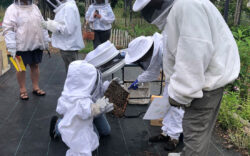If you’re trying to attract birds and beneficial insects to feast on the pests in your garden, you might want to consider a nighttime insectivore as well: the bat. This tiny mammal can eat pounds of insects, including mosquitoes, during the summer. Bats’ small footprint homes, declining populations and nightly bug binges are great reasons to consider adding a bat garden to your yard.
Bats are not dangerous, as long as humans aren’t handling them. The much maligned, yet still creepy, bloodsucking varieties don’t live this far north. “We don’t have vampire bats,” said Athens-Clarke County extension agent Laura Ney. “We have entirely insect-eating bats.”
Yes, bats can carry rabies. But like other rabies vectors, such as skunks, raccoons and foxes, the easiest way to prevent contact is to never, ever pick up a wild critter. Bats aren’t curious about trash, like raccoons, or recently planted bushes, like armadillos, or outdoor pet food, like possums.
“[Bats] stay out of our way,” said Suzanne DeGrasse, a state and federally permitted wildlife rehabilitator who operates Primarily Possums, a licensed nonprofit in Danielsville, “just as we stay out of their way.
“Their guano [bat poop] is really only a problem when you have large numbers of bats inside an attic,” she added.
Bats are good neighbors to humans. Besides munching on mosquitoes, several national and international studies indicate that planned bat colonies near commercial agriculture reduce the need for pesticides and keep crop-damaging nasties in check. “[Bats] are actually this weird formally unrecognized part of our food system,” Ney said. “They are eating a significant number of pests.”
If you’ve tried to grow corn in your backyard, you might’ve found a caterpillar at the top of the cob, grinding kernels into mushy paste. That’s the larval stage of the corn earworm moth, and a particular favorite meal for bats.
Despite their useful nature, bat populations are declining. “We are losing a great number of them to habitat destruction and disease,” DeGrasse said.
I have bats and I have a bat box, but I have no bats in said box. The little colony prefers, so far, to roost in the tin roof panels of my home, shrieking in irritation when the metal heats to roasting temperatures in the summer.
Getting bats into a bat house is not a new dilemma, DeGrasse said. “Unfortunately, they have their own agenda,” she said. “Bats are a creature we definitely need to give a helping hand to, but it can be a challenge.”
A bat garden contains a bat house, as well as native plants attractive to their favorite snacks. Dudley Park sports several bat boxes and a small bat garden cared for by the Athens Area Master Gardeners. The Dudley Park Bat Garden includes yucca, goldenrod and coneflowers. Master gardeners will be replanting and filling out the area this spring, Ney said.
For an extra bat boost, I’d suggest night-blooming plants, such as vining moonflower, old-fashioned four o’clocks, evening scented stock and night phlox. I’m a fan of night-blooming plants already, and that they help support bats is just another good reason for me to consider formalizing a future midnight garden.
Bat box placement can be the trickiest part of the equation, Ney said. Like any prospective homebuyer, bats can be picky about location. “They prefer a house where the sun is hitting it in the morning,” she said. “They need to kind of warm up and dry off in the morning.” Bats also want to avoid the summer afternoon sun, where they might end up cooking in their tiny roosts.
Bats prefer homes high off the ground. “The taller the better is what I’ve heard,” Ney said. But bats might forgo boxes attached to trees, avoiding any loss of pups (baby bats) to climbing snakes.
If you’re interested in seeing bat gardens at work, you can visit Dudley Park or the ACC Extension Office Demonstration Garden at 275 Cleveland Road. Resources with more bat facts, as well as DIY instructions to build and place bat boxes, are available at primarilypossums.com and Bat Conservation International at batcon.com.
Whether you jump into constructing a bat box, grow a night-blooming flower, or take a garden tour, I’d suggest exploring the beauty of our garden ecosystems at night. “Humans need to cultivate our sense of wonder and curiosity about the world in which we live,” DeGrasse said. “We are just a part of a greater ecosystem, and there’s so much else to learn about everybody we share this space with.”
Like what you just read? Support Flagpole by making a donation today. Every dollar you give helps fund our ongoing mission to provide Athens with quality, independent journalism.










